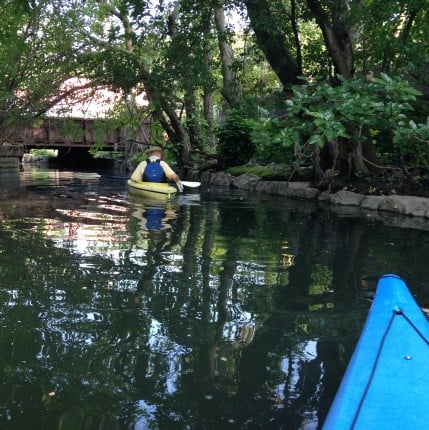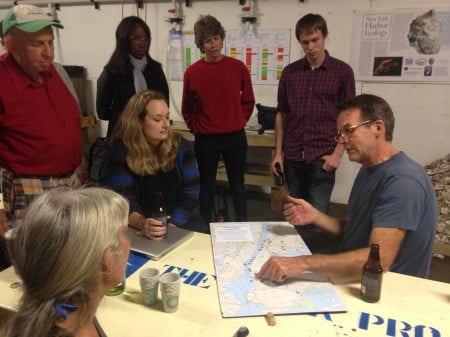Highlights from 2014 Community Science Water Quality Sampling

Sampling began on the Quassaick Creek in August, 2014. Photo Courtesy John Gephards / Quassaick Creek Watershed Alliance
View more images on our Flickr site
It was a milestone year for Riverkeeper’s community science projects. In all, Riverkeeper is now supporting sampling for Enterococcus, the EPA-recommended fecal-indicator of recreational water quality, and reporting data from 149 locations along seven Hudson River tributaries and the New York City waterfront. That’s in addition to the 74 sites sampled monthly via our patrol boat in conjunction with our science partners, CUNY Queens College and Lamont Doherty Earth Observatory.
Most exciting are the grassroots projects inspired by these water quality testing projects. Here’s a look at some of the highlights from 2014. We hope this list helps individuals, governments and groups throughout the Hudson River watershed identify strategies to make use of this data to help clean the water:
New York City

Citizen scientists with the New York City Water Trail Association, the River Project and area boat clubs met to see the 2014 data and talk about next steps. (Photo by Dan Shapley / Riverkeeper)
After consultation with Riverkeeper in 2011, the New York City Water Trail Association began the largest of our community partnered projects, and now samples nearly 40 locations weekly in cooperation with the members of boat clubs and other waterfront groups. In 2014, Riverkeeper began publishing this rich dataset on our website, itself a milestone. Advocacy by Long Island City Boat House and HarborLab also prompted the NYC Department of Environmental Protection to identify a source of pollution to Hallets Cove on the East River, and an enforceable plan is in place to stop the pollution. The Water Trail Association is also a model for bringing together advocates and keeping them engaged by keeping things fun, as exemplified by its annual wrappup session where data is presented, issues are discussed—and the Golden Toilet Award is bestowed.
Sparkill Creek
The Sparkill Creek Watershed Alliance is Riverkeeper’s oldest partner for citizen sampling, having begun testing in 2011. With separate funding from NEIWPCC, the group expanded research into additional areas, and with additional parameters, including some pilot studies of DNA that may ultimately help distinguish bacteria that originates in humans versus other animals. The Sparkill Creek Watershed Alliance will make a presentation along with other groups working on citizen science in New York and New Jersey, later this month at forum presented by the NY-NJ Harbor Estuary Program and the Environmental Protection Agency.
Pocantico River
A Pocantico River Watershed Roundtable, organized by the Hudson River Watershed Alliance and hosted by the Rockefeller Preserve in September brought attention to the creek and resolve to participants. Presentations covered topics including water quality, ecology, and watershed planning. The conference was well attended by representatives from state, county and local levels of government. Some interest in an intermunicipal effort to track sources has since been discussed.
Quassaick Creek

Sampling began on the Quassaick Creek in August, 2014. Photo Courtesy John Gephards / Quassaick Creek Watershed Alliance
The Quassaick Creek Watershed Alliance began sampling the Quassaick Creek only in August, and in no time members had identified a potential source of contamination to the City of Newburgh’s drinking water supply. Thanks to a close collaborative relationship with city leaders, the alliance worked with the city to pay for additional testing to track down contamination sources. Members of the Quassaick Creek Watershed Alliance have also emerged as leaders regionally in conducting a series of stream walks aimed at learning more about their creek, identifying potential problem spots, and developing plans of action for addressing them.
Wallkill River
After a presentation by Riverkeeper staff to a joint session of the town and village boards last winter, New Paltz has emerged as a hub for action on the Wallkill River. At the request of the village’s Environmental Conservation Board, Riverkeeper developed signage to be displayed at Village Hall showing the results from the first two years of sampling, and contextual information to help the public better understand what the results mean. And Village Mayor Jason West is leading the charge to organize, with support from the Center for Regional Research, Education and Outreach at SUNY New Paltz, a Wallkill River Summit that will bring together decision makers and others throughout the watershed in 2015 around the longterm goal of making the river safe for swimming.
Rondout Creek
Strong interest from the communities bordering the Rondout Creek was evident, as both Rosendale and Rochester invited Riverkeeper staff to make public presentations about our data which in total were attended by well over 100 people. In both towns, as well as upstream in Wawarsing, local environmental advisory boards and conservation commissions have adopted Riverkeeper-partnered water quality sampling as team projects, and they are bringing their knowledge of, and relationships with, local government to the task of cleaning the water. After Riverkeeper staff organized a meeting with the sewer operator in Town of Woodstock, the only Hudson Valley town known to maintain two septic districts, an intermunicipal group began meeting under the name Save the Rondout to identify ways to address contamination in a creek that has many popular, if unofficial, swimming areas. The Town of Rochester deserves a special shout-out for bringing people who love the creek together around a fun event that included a Riverkeeper staff presentation and a celebration with music, food and beer. These types of events help build a strong community of advocates for the creek.
Esopus Creek
With the recruitment of new partners, community sampling on the Esopus Creek expanded to include additional sub-tributaries. We are exploring ways to expand testing, and action based on the results, in 2015.
Catskill Creek
Expansion of testing into Scoharie County was made possible after Riverkeeper and Cornell Cooperative Extension of Greene County staff presented information about the first two years of data collection. Now, 19 samples are taken monthly on 45 miles of creek.
Riverkeeper is proud to say we’ve reached capacity with our existing laboratory equipment and staff. But that has not stopped us from exploring new partnerships. A community science project organized by Sarah Lawrence College’s Center for the Urban River at Beczak expects to begin a sampling program on the Saw Mill River in 2015, after a year of planning that included consultation with Riverkeeper and our science partners. And we are discussing partnerships with various groups, universities, businesses and individuals who are interested in expanding testing to additional stretches of the Hudson River and its tributaries.
This document was prepared with support from the Hudson River Estuary Program, New York State Department of Environmental Conservation, with support from the New York State Environmental Protection Fund, in cooperation with the New England Interstate Water Pollution Control Commission. The viewpoints expressed here do not necessarily represent those of NEIWPCC or NYSDEC, nor does mention of trade names, commercial products, or causes constitute endorsement or recommendation for use.
Generous funding for this ongoing collaborative project between Riverkeeper, CUNY Queens College and Columbia University’s Lamont-Doherty Earth Observatory has been provided by the HSBC Water Programme, the Dextra Baldwin McGonagle Foundation, Inc., the Hudson River Foundation, RBC Blue Water Project, the Brinson Foundation, and Riverkeeper members.
